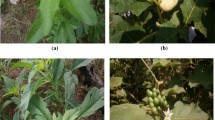Abstract
In the western Sahel, indigenous plants become important staples when cereal harvests are inadequate to support populations inhabiting that region of Africa. The purpose of this study was to assess the nutrient content of several of these edible wild plants. The leaves of the following seven plant foods were analyzed: Ziziphus mauritiana, Cerathotheca sesamoides, Moringa oleifera, Leptadenia hastata, Hibiscus sabdarifa, Amaranthus viridi, and Adansonia digitata. The fatty acid, vitamin E, carotenoid, selected mineral and amino acid contents of these plant foods were determined. These same analyses were performed on the fruit of the Adansonia digitata. In quantitative and qualitative terms, Amaranthus viridis was found to be an excellent source of protein. Its amino acid composition compared favorably to that of a World Health Organization (WHO) protein standard. It also contained considerable amounts of the two fatty acids that are essential in humans (linoleic and α-linolenic) and a number of minerals including iron, magnesium, calcium and zinc. The leaves of Hibiscus sabdarifa contained an appreciable quantity of protein the composition of which was comparable to the WHO standard. The mineral content of the leaves of this plant was also exceptionally high; noteworthy was its high zinc content. H. sabdarifa also contained significant quantities of the two essential fatty acids. Ziziphus mauritiana was an excellent source of the essential fatty acid linoleic acid and several of the metals including iron, calcium, magnesium and zinc. Its content of other essential nutrients, however, was rather low. In general, Adansonia digitata leaves were nutritionally superior to the fruit of the tree; however, the fruit did contain useful quantities of potassium, phosphorus, zinc and α-linolenic acid. The Leptadenia hastata leaves were an especially good source of lutein and β-carotene. These data should be useful to the people who inhabit the western Sahel in helping them devise healthy diets during times when cereal staples are in short supply.
Similar content being viewed by others
References
Salih OM, Nour AM, Harper DB (1991) Chemical and nutritional composition of two famine food sources used in Sudan, mukheit (Bogosia senegalensis) and maikah (Dobera roxburghi). J Sci Food Agric 57: 367–377.
Humphry CM, Clegg MS, Keen CL, Grivetti LE (1993) Food diversity and drought survival. The Hausa example. Int J Food Sci Nutr 44: 1–16.
Smith GC, Grivetti LE (1994) Cultural use of edible wild plants in Burkina Faso, West Africa. FASEB J 8: A183.
Ross PJ, Etkin NL, Muazzamu I (1996) A changing Hausa diet. Medical Anthropology 17: 143–163.
Smith GC, Clegg MS, Keen CL, Grivetti LE (1996) Mineral values of selected plant foods common to southern Burkina Faso and to Niamey, Niger, West Africa. J Food Sci Nutr 47: 41–53.
Kim TS, Pastuszyn A, VanderJagt DJ, Glew RS, Milson M, Glew RH (1997) The nutritional composition of seeds from Boscia senegalensis(Dilo) from the Republic of Niger. J Food Comp Anal 10: 73–81.
Yazzie D, Vanderjagt DJ, Pastuszyn A, Okolo A, Glew RH (1994) The amino acid and mineral content of baobab (Adansonia digitata L.). J Food Comp Anal 7: 183–193.
Smith GC, Dueker SR, Clifford AJ, Grivetti LE (1995) Carotenoid values of selected plant foods common to southern Burkina Faso, West Africa. Ecol Food Nutr 30: 1–16.
Hirs CWH (1967) Performic acid oxidation. Methods Enzymol 11: 197–199.
Hugli TE, Moore S (1972) Determination of the tryptophan content of proteins by ion exchange chromatography of alkaline hydrosylates. J Biol Chem 247: 2828–2834.
Cohen SA, Strydom DJ (1988) Amino acid analysis utilizing phenylisothiocyanate derivatives. Anal Biochem 174: 1–16.
Buzzigoli G, Lanzone L, Ciorciaro D, Frascerra S, Cerri M, Scandroglio A, Coldani R, Ferrannini E (1990) Characterization of a reversed-phase high performance liquid cromatographic system for determination of blood amino acids. J Chromatogr 507: 85–93.
Bidlingmeyer BA, Cohen SA, Tarvin TL (1984) Rapid analysis of amino acids using pre-column derivitization. J Chromatogr 336: 93–104.
Morrison WR, Smith LM(1964) Preparation of fatty acid methyl esters and dimethylacetals from lipids with boron trifloride-methanol. J Lipid Res 5: 600–608.
WHO (1985) WHO/FAO Report: Energy and protein requirements. WHO technical report series No. 724. World Health Organization, Geneva.
Grivetti LE, Frentzel CJ, Ginsberg KE, Howell KL, Ogle BM (1987) Bush foods and edible weeds of agriculture. Prospectives on dietary use of wild plants in Africa, their role in maintaining human nutritional status and implications for agricultural development. In RR Akhtar (ed.), Health and Disease in Tropical Africa. Geographical and Medical Viewpoints, pp. 51–81. New York: Harwood.
Laryea MD, Mayatepek E, Ahmed HM, Gillhausen K, Leichsenring M, Lombeck I, Bremer HJ (1992) Composition of foods and dishes commonly consumed in villages of the Gezira area of Sudan. III. Fatty acids, retinol, α-, β-carotene and tocopherols. Ecol Food Nutr 26: 333–343.
Author information
Authors and Affiliations
Rights and permissions
About this article
Cite this article
Sena, L., VanderJagt, D., Rivera, C. et al. Analysis of nutritional components of eight famine foods of the Republic of Niger. Plant Foods Hum Nutr 52, 17–30 (1998). https://doi.org/10.1023/A:1008010009170
Issue Date:
DOI: https://doi.org/10.1023/A:1008010009170




